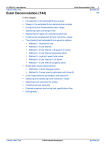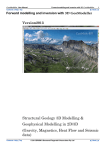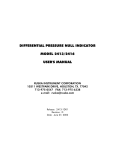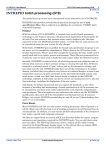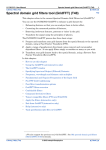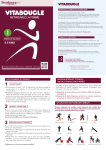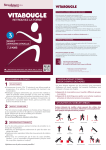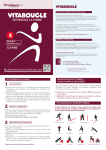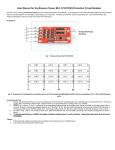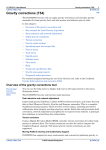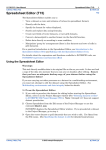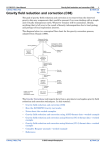Download Estimating depth to Moho and Isostatic correction (T55)
Transcript
INTREPID User Manual Library | Help | Top Estimating depth to Moho and Isostatic correction (T55) 1 | Back | Estimating depth to Moho and Isostatic correction (T55) Top Introduction The Intrepid Isostatic tool is a rewrite of the USGS fortran program airyroot. Airyroot calculates an airy isostatic regional at sea level out to 166.7 km. At present the Isostatic tool runs in a batch process only. Usage: isostatic.exe -batch jobfile The outputs from the program are: 1 Depth to Moho (Airyroot) grid in kms 2 Isostatic gravity correction grid in mGals Then it is a simple matter of subtracting the correction grid from the Bouguer gravity grid, to create an Isostatically corrected Bouguer gravity grid. Earth curvature corrections are not done beyond 166.7 km – see discussion below. Note that you must work in projected coordinates (Geodetic is not supported). Sample task file # example of Parker style isostatic correction job (uses FFTW) Process Begin Name = isostatic Parameters Begin InputGridName = ./DEM_Onshore_Offshore_Airy.ers DepthMohoGridName = ./depth_moho.ers FilteredGridName = ./isostatic_correction.ers FftGridName = ./iso_fft.ers #WindowedGridName = ./iso_wind.ers ExpandedGridName = ./iso_exp.ers #AmplitudeGridName = ./iso_amp.ers #CoefficientGridName = ./iso_coeff.ers Band = 0 OutputPrecision = IEEE4ByteReal DetrendDegree = 0 # must be DC! RolloffType = COSINE #WindowType = HANNING FillType = ARTHUR ReApplyTrendAfterReverseFft = 0 ApplyMaskAfterReverseFft = 1 UseSymmetry = Yes DiskUsageRule = AUTO # FORCE_MEMORY, FORCE_DISK # now for the specific isostatic parms SupplyMohoGrid = No #Moho grid calc from DEM SubtractFlatEarthRoot = Yes #Subtract flatearth >166.7 Sea_Level_Root_Depth = 32 Crust_Density = 2.670 Density_Constrast_Depth = 0.6 Max_Tolerance = .005 Max_Iterations = 6 MaxBesselSize = 150000 #Default-Increases Bessel array size Parameters End Process End Library | Help | Top © 2012 Intrepid Geophysics | Back | INTREPID User Manual Library | Help | Top Estimating depth to Moho and Isostatic correction (T55) 2 | Back | Input files Input is a standard INTREPID or ERMapper format grid of topography. At present, INTREPID does not support the surface 'load' grid option allowed in Airyroot. Contact Intrepid Support if you would like this option to be added to the Isostatic tool (see discussion below regarding this option). The topographic grid must be in a projected coordinate system. INTREPID does not support geodetic projections and coordinates. The topography grid must contain elevation values in metres at grid points. Ocean depths must have 50,000m subtracted from them as a flag to distinguish negative onland elevations (for example Death Valley). If a surface load grid, then values at grid points are equal to the mass excess (or deficiency if negative) resulting from the topographic features in units of g/cm2. Note that ocean depths give a negative load because the water ought to be granite in this scheme. A load grid is necessary as input if lakes, glaciers, and variable densities for topographic features are to be properly handled. Using a depth to Moho grid from another source You can use a depth to Moho grid from an alternative source. In the job file set the parameter SupplyMohoGrid = Yes or 1. The parameter DepthMohoGridName is now the input grid for the isostatic correction and INTREPID does not calculate the Moho grid from the input DEM. If you are using a DEM to calculate the Moho, the grid must be depth to Moho in km as calculated. The grid can be a different size or have a different cell dimension to your DEM which is not used in this case. Process Begin Name = isostatic Parameters Begin InputGridName = ./DEM_Onshore_Offshore_Airy_500m.ers DepthMohoGridName = ./depth_moho_500m_user.ers Subset Begin XLower = Null XUpper = Null YLower = Null YUpper = Null FFTborder = 5000.0 Subset End FilteredGridName = ./isostatic_correction_MyMoho.ers FftGridName = ./isostatic_fft.ers #WindowedGridName = ./isostatic_wind.ers ExpandedGridName = ./isostatic_exp.ers #AmplitudeGridName = ./isostatic_amp.ers #CoefficientGridName = ./isostatic_coeff.ers Band = 0 OutputPrecision = IEEE4ByteReal DetrendDegree = 0 ## must be DC! RolloffType = COSINE WindowType = NONE Library | Help | Top © 2012 Intrepid Geophysics | Back | INTREPID User Manual Library | Help | Top Estimating depth to Moho and Isostatic correction (T55) 3 | Back | FillType = ARTHUR ReApplyTrendAfterReverseFft = No ApplyMaskAfterReverseFft = Yes UseSymmetry = Yes DiskUsageRule = AUTO # FORCE_MEMORY, FORCE_DISK # now for the specific isostatic parms SupplyMohoGrid = Yes #Supply a moho grid SubtractFlatEarthRoot = Yes #Subtract flat earth >166.7kms Sea_Level_Root_Depth = 32 Crust_Density = 2.670 Density_Constrast_Depth = 0.6 Max_Tolerance = .005 Max_Iterations = 6 MaxBesselSize = 150000 #Default-Increases Bessel array size Parameters End Process End Earth curvature corrections Gravitational attraction of Airy root on a flat earth is calculated using Parker's fast Fourier transform algorithm. Attraction of a flat earth root beyond 166.7 km is calculated using an approx to an integral containing a Bessel function. This latter is subtracted (subroutine subtract_far) to leave attraction of root out to 166.7 km. Beyond that approximate distance the curvature of the earth becomes important. The calculation and subtraction of the flat earth root correction is provided as an option in the batch file: SubtractFlatEarthRoot = 1 or yes turns the calculation on. Believers in the flat earth hypothesis can turn this calculation off. Output files INTREPID writes outputs as standard INTREPID or ERMapper format grids. The first output is the Moho depth grid containing the airy root depth in km. INTREPID uses this grid to derive the second output. This is the gravitational attraction in milligals at sea level of an Airy root system out to a distance of 166.7 km from each observation point. The output grid must be combined with a solution beyond 166.7 km to make a complete Airy regional. The break occurs at 166.7 km because: Library | Help | Top • Terrain corrections for Bouguer gravity generally stop at this distance • The earth's curvature, which is not accounted for in this program, starts to become important at about this distance. © 2012 Intrepid Geophysics | Back | INTREPID User Manual Library | Help | Top Estimating depth to Moho and Isostatic correction (T55) 4 | Back | Memory management Depending on the memory or swap space available on your computer, you may need to adjust some INTREPID parameters such as INTREPID_MEMORY, which defaults to 512 Mb. Reducing the size of this variable will result in use of less physical memory and force the program to page to disk. For instrucitions on chanign this parameter, see "Ways of setting INTREPID system parameters and environment variables" in INTREPID system parameters and install.cfg (R07). Alternatively, you can use the DiskUsageRule parameter in the job file. The options are: DiskUsageRule = AUTO or FORCE_DISK or FORCE_MEMORY The default is AUTO and in this case the program manages memory usage in conjunction with the INTREPID_MEMORY variable as discussed above. If you have problems with memory, you can use the FORCE_DISK option to force all memory usage to disk. This will allow INTREPID to manage much larger input grids without over-using physical memory. However, processing will be much slower using this method. INTREPID creates large temporary files during program execution. It removes most of these when the program finishes. Two of the files remain after processing: • Forward FFT (FftGridName) • Expanded grid name (ExpandedGridName). We have left these in place for chacking purposes while the program is still in beta. Further issues Please note the following warnings: • Avoid using high resolution grids for input. The wavelengths in the isostatic are long so 1km cell grids are sufficient for computing the correction unless topography contains extreme gradients. • Do not use any detrending during the FFT processing as this will impact long wavelengths in the isostatic. • Use of the FFT based algorithm causes some errors on the boundaries of the isostatic gravity correction grid due to the wrapping procedure employed. If you are concerend about this then we recommend that you make the input DEM or bathymetry grid approximately 30% larger than the area for which you are calculating the isostatic. To remove any edge effects it is possible to use the Source_Grid option in the FFT options and set a subarea for the final result so that it is free of any edge effects. Library | Help | Top © 2012 Intrepid Geophysics | Back | INTREPID User Manual Library | Help | Top Estimating depth to Moho and Isostatic correction (T55) 5 | Back | For an example of this, see Job file example below: # example of Parker style isostatic correction job file # using subset # to limit problems with edge effects # uses FFTW Process Begin Name = isostatic Parameters Begin Subset Begin XLower = -141500.0 XUpper = 847500.0 YLower = 5219000.0 YUpper = 6338000.0 FFTborder = 100000.0 SubsetGridName = DEM_subset100k Subset End InputGridName = ./DEM_Onshore_Offshore_Airy.ers DepthMohoGridName = ./depth_moho_subset100k.ers FilteredGridName = ./isostatic_correction_subset100k.ers FftGridName = ./fft_subset100k.ers WindowedGridName = ./wind_subset100k.ers ExpandedGridName = ./exp_subset100k.ers #AmplitudeGridName = ./amp_subset100k.ers #CoefficientGridName = ./coeff_subset100k.ers Band = 0 OutputPrecision = IEEE4ByteReal DetrendDegree = 0 ## must be DC! RolloffType = Cosine WindowType = None FillType = SOURCE_GRID ReApplyTrendAfterReverseFft = 1 ApplyMaskAfterReverseFft = 1 UseSymmetry = Yes DiskUsageRule = AUTO #FORCE_MEMORY, FORCE_DISK # now for the specific isostatic parms SupplyMohoGrid = No #Moho grid is calculated from DEM SubtractFlatEarthRoot = Yes #Subtract flat earth >166.7kms Sea_Level_Root_Depth = 32 Crust_Density = 2.670 Density_Constrast_Depth = 0.6 Max_Tolerance = .005 Max_Iterations = 6 MaxBesselSize = 150000 #Default-Increases Bessel array size Parameters End Process End Library | Help | Top © 2012 Intrepid Geophysics | Back | INTREPID User Manual Library | Help | Top Estimating depth to Moho and Isostatic correction (T55) 6 | Back | Frequently asked questions Q : What does Dea Level Root depth mean? This is the depth in metres of the Airy mass balance cylinder. This is normally 32000m. Sea_Level_Root_Depth = 32 We have tried 30 km and found 32 km is better for Australia It is possible to try various column depths and densities quite quickly as the output is generated promptly and the reasonableness of the result is very sensitive to the parameters. The aim is to get an output where there is no regional. Q : What are typical density values that I can use Here are some common density values Library | Help | Top Medium Density in kg/m3 Sea water 1027 Crust density 2670 Mantle density 3300 © 2012 Intrepid Geophysics | Back |






